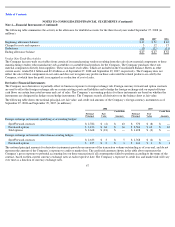Apple 2008 Annual Report Download - page 65
Download and view the complete annual report
Please find page 65 of the 2008 Apple annual report below. You can navigate through the pages in the report by either clicking on the pages listed below, or by using the keyword search tool below to find specific information within the annual report.
Table of Contents
NOTES TO CONSOLIDATED FINANCIAL STATEMENTS (Continued)
Note 1—Summary of Significant Accounting Policies (Continued)
Allowance for Doubtful Accounts
The Company records its allowance for doubtful accounts based upon its assessment of various factors. The Company considers historical
experience, the age of the accounts receivable balances, credit quality of the Company’s customers, current economic conditions, and other
factors that may affect customers’ ability to pay.
Shipping Costs
For all periods presented, amounts billed to customers related to shipping and handling are classified as revenue, and the Company’s shipping
and handling costs are included in cost of sales.
Warranty Expense
The Company generally provides for the estimated cost of hardware and software warranties at the time the related revenue is recognized. The
Company assesses the adequacy of its preexisting warranty liabilities and adjusts the amounts as necessary based on actual experience and
changes in future estimates. For products accounted for under subscription accounting pursuant to SOP No. 97-2, the Company recognizes
warranty expense as incurred.
Software Development Costs
Research and development costs are expensed as incurred. Development costs of computer software to be sold, leased, or otherwise marketed are
subject to capitalization beginning when a product’s technological feasibility has been established and ending when a product is available for
general release to customers pursuant to SFAS No. 86, Computer Software to be Sold, Leased, or Otherwise Marketed . In most instances, the
Company’s products are released soon after technological feasibility has been established. Therefore, costs incurred subsequent to achievement
of technological feasibility are usually not significant, and generally most software development costs have been expensed.
During 2008, the Company capitalized $11 million of costs associated with the development of Mac OS X Version 10.6 Snow Leopard. In 2007,
the Company determined that both Mac OS X Version 10.5 Leopard (“Mac OS X Leopard”) and iPhone achieved technological feasibility.
During 2007, the Company capitalized $75 million of costs associated with the development of Leopard and iPhone. In accordance with SFAS
No. 86, the capitalized costs related to Mac OS X Leopard and iPhone are amortized to cost of sales commencing when each respective product
begins shipping and are recognized on a straight-line basis over a 3 year estimated useful life of the underlying technology.
Total amortization related to capitalized software development costs was $27 million, $13 million, and $18 million in 2008, 2007, and 2006,
respectively.
Advertising Costs
Advertising costs are expensed as incurred. Advertising expense was $486 million, $467 million, and $338 million for 2008, 2007, and 2006,
respectively.
Stock-Based Compensation
The Company applies SFAS No. 123 (revised 2004), Share-Based Payment , for stock-based payment transactions in which the Company
receives employee services in exchange for (a) equity instruments of the enterprise or (b) liabilities that are based on the fair value of the
enterprise’s equity instruments or that may be settled by the issuance of such equity instruments. The Company uses the Black-Scholes-Merton
(“BSM”) option-pricing model to determine the fair-value of stock-based awards under SFAS No. 123R.
SFAS No. 123R prohibits recognition of a deferred tax asset for an excess tax benefit that has not been realized. The Company will recognize a
benefit from stock-based compensation in equity if an incremental tax benefit is
62
























